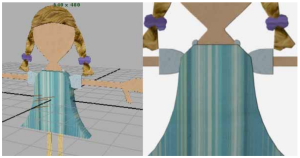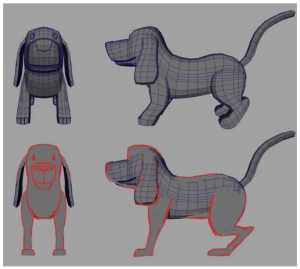In her Master of Fine Arts in the Graduate School of The Ohio State University thesis, Laura Beth Albright develops a “toolbox” of 2D and 3D spatial design principles made for 3D animations. She builds this kit by examining the traditional principles of graphic design and cinematography. Putting this toolbox to use she creates two films, the first combining 3D models with 2D drawings, and the second using 2D line art to generate 3D animation.
Albright splits her toolset up into 2 different categories: direct content tools and indirect composition results. Under direct content tools are concepts including but not limited to color and texture; contract and differentiation; repetition, similarity, and pattern; and lens angle. The direct content tools relate directly to elements that the filmmaker can edit in regards to visual image design. These edits affect the resulting composition. Under the second category of indirect composition results are figure/ ground relationship; staging and silhouette; visual hierarchy; and the such. This second category deals with broader spatial design principles that are directly affected by the use of the first category. It is involved with evaluating rather than editing a composition.
With the defined toolkit, Albright analyzes previously published films that combine 3D computer animated images with hand drawn 2D images. The range of works examined, including Lemony Snicket’s A Series of Unfortunate Events and Flatworld, displays the different techniques and approaches in spatial design used to create illusory depth and flatness. Albright takes from her studies the two ends of the spectrum, deep 3D space versus compressed space, and applies it to her own animated film productions.
Goldilocks, Redirected is the first of the films directed and made by Albright as a part of her thesis. The aim of this film was to achieve compressed space by using tactics of overlaying 2D over 3D models. While the base animation is done in Maya the 3D software, the models seem flat and look like paper cutouts. Applied textures add to the 2D feel. The most important technique used, however, is overlapping. 3D models were made with added depth in certain areas to darken shadows, exaggerating the 2D effect of the models.
The second of the films, A Litter of Perfectly Healthy Puppies Raised on Fried Pancakes, presents an opposite goal: the illusion of deep 3D space. Using the line drawings from Thurber’s Dogs, 3D space is implied with contour lines. The line drawings suggest 3D space with linear perspective and overlapping of objects depending on the distances from the camera. Albright uses the 2D line drawings and creates a 3D model that mimics the drawings. Solid cartoon lines are applied to outline the 3D model which is animated and rendered. During rendering, however, all interior detail including shading, reflection and the such, are removed to make the image seem as though it were strictly two dimensional.
With the defined toolkit, Albright displays that a variety of effects can be achieved through using a combination of 2D and 3D animation. Her two animations show two ends of the spectrum of what her toolkit can be used for. In the future, this toolkit may also be applied for the making of stereoscopic 3D film. Albright poses alternate possibilities and a new range of what animation may be like in the future, especially with the development of new technology.
Albright, Laura Beth. 2D Spatial Design Principles Applied To 3D Animation: A Proposed Toolset For Filmmakers. Thesis. The Ohio State University, 2009. Web.





